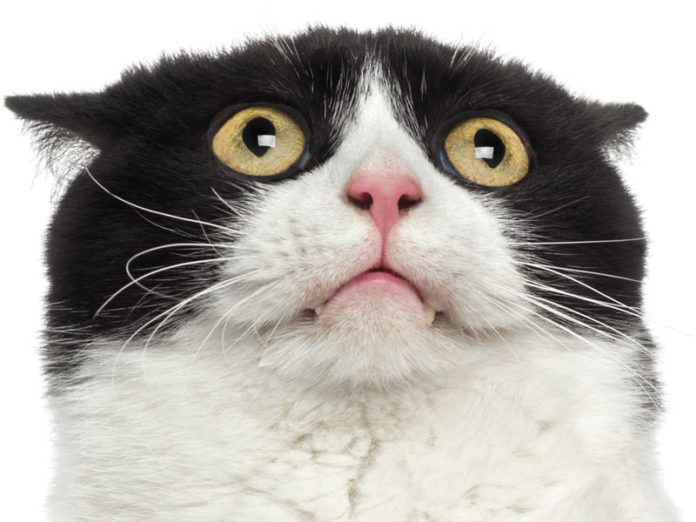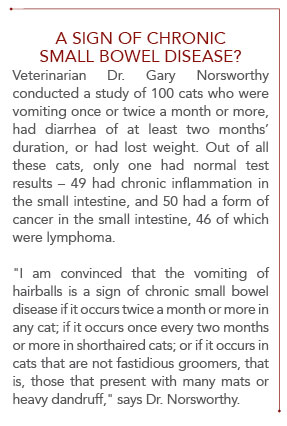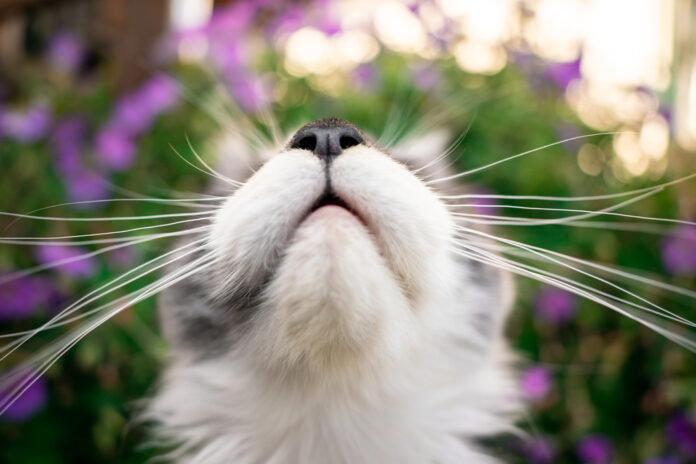Preventing hairballs in cats

They’re more than just a mess for you to clean up. Excessive hairballs can signal a health problem or an inappropriate diet.
Many cat parents accept hairballs as a normal part of life. It’s true that the occasional hairball may not be anything to worry about. But too many can signal a more serious health issue, and should not be taken lightly.
“Hairballs are rarely the problem,” advises homeopathic veterinarian Dr. Andrea Tasi. “They are usually a symptom of another issue.”
What exactly is a hairball?
Traditionally, it was thought that hairballs develop because of how cats groom themselves. As a cat licks her fur, the tongue’s tiny barbs pull off excess hair. Inevitably, some of it gets swallowed in the process. Ideally, it passes through the body and ends up in the cat’s stools. Hairballs form when hair wads up in the stomach instead.
More recent findings show that hairballs form because the cat’s gut health may be compromised. A healthy gut is populated with microscopic organisms, predominantly healthy bacteria, also known as gut flora. This gut flora carries out many important functions. It helps neutralize some of the toxic by-products of the digestive process, reduces harmful substances such as carcinogens, and discourages “bad” bacteria and yeasts. It also helps stimulate the digestive process. Recent research has shown that a healthy gut is one of the most important foundations of a healthy immune system.
A healthy cat will be able to eliminate ingested hair without any problems. In cats with compromised gut health, however, intestinal motility is impaired, something that commonly occurs secondary to inflammatory bowel disease. Instead of the hair easily passing through the digestive tract, it balls up in the stomach, and ultimately, the cat will vomit it up. In extreme cases, when motility is severely compromised, hairballs may form gastric obstructions that require surgical removal.
 Preventing the problem
Preventing the problem
1. Grooming: Regular brushing or combing to get rid of loose hair before your cat ingests it certainly helps prevent hairballs, especially in longhaired cats. Nature did not intend cats to have as much fur as Persians or Himalayans do; their digestive tracts are not designed to move such large amounts of hair on a regular basis. Even shorthaired cats may need grooming help at peak shedding times. This applies to indoor cats as well, since shedding is mediated by the number of daylight hours rather than temperature.
2. Diet: Even more importantly, there seems to be a strong connection between diet and hairballs. High quality grain-free canned food or raw diets provide an answer to hairball problems. Cats are obligate carnivores, so their digestive systems are not able to digest grains and carbs well.
“Every day, there’s more scientific evidence that hairballs may respond to a diet that looks like what a cat evolved to eat,” says feline veterinarian Dr. Fern Crist.
So-called commercial hairball diets may do more harm than good to the cat’s gut health. They’re high in fiber, the theory being that it will help propel the hair through the digestive system. However, the opposite seems to happen in many cats: the unnaturally high fiber levels contribute to impaired intestinal motility and actually lead to more vomiting. In most cases, a grain-free diet seems to be a better choice.
What about hairball remedies?
Many commercial hairball remedies are petrolatum-based. They are designed to lubricate the intestinal tract and aid the passage of hairballs. Petrolatum, or petroleum jelly, is derived from crude oil. Does this really belong inside a cat’s stomach? Definitely not, says Dr. Crist: “A cat is not a car. And in no way could a cat have naturally evolved to require dosing with ‘lubricants’ to survive or thrive.”
If your cat has a significant hairball problem, take her to the vet for check-up to make sure she doesn’t have an underlying health issue. Also consider switching her to a better quality, more species-appropriate grain-free diet, and groom her on a regular basis. “Look to nature as a model,” says Dr. Tasi.



